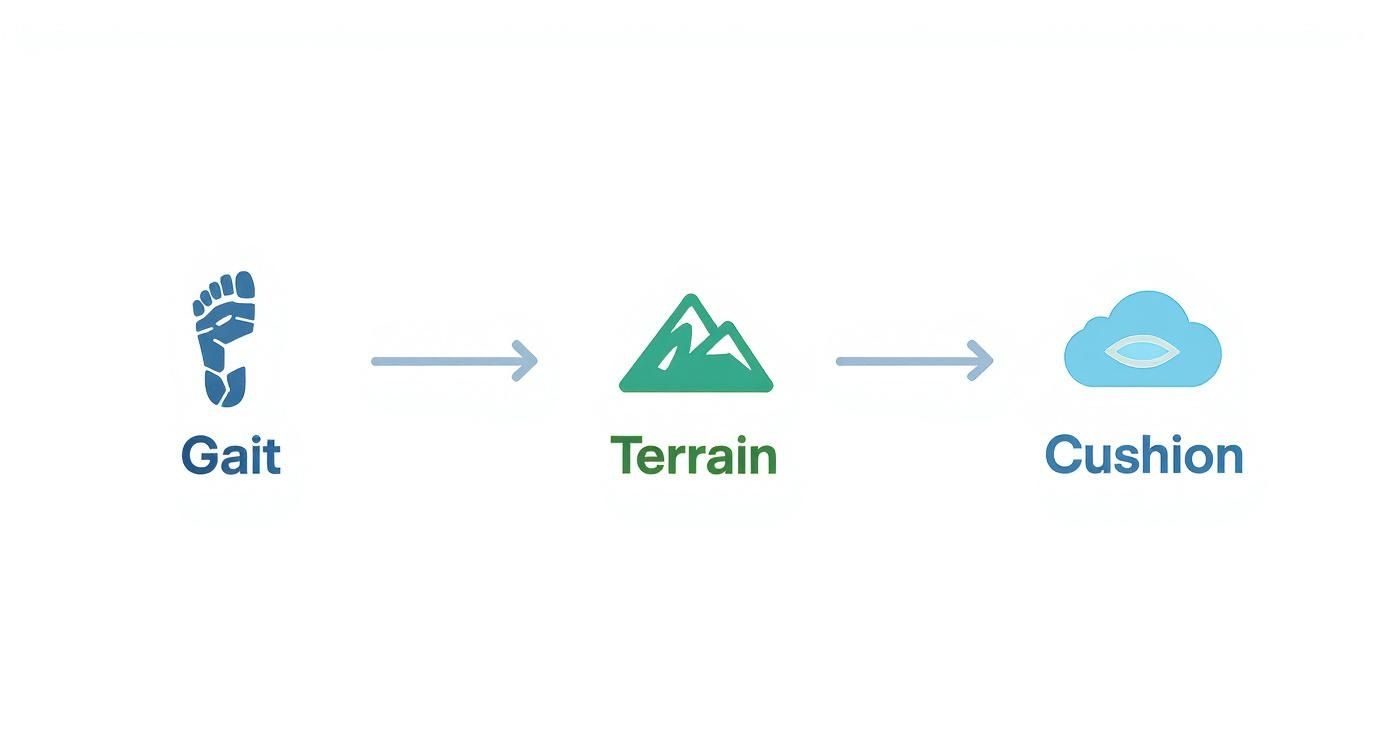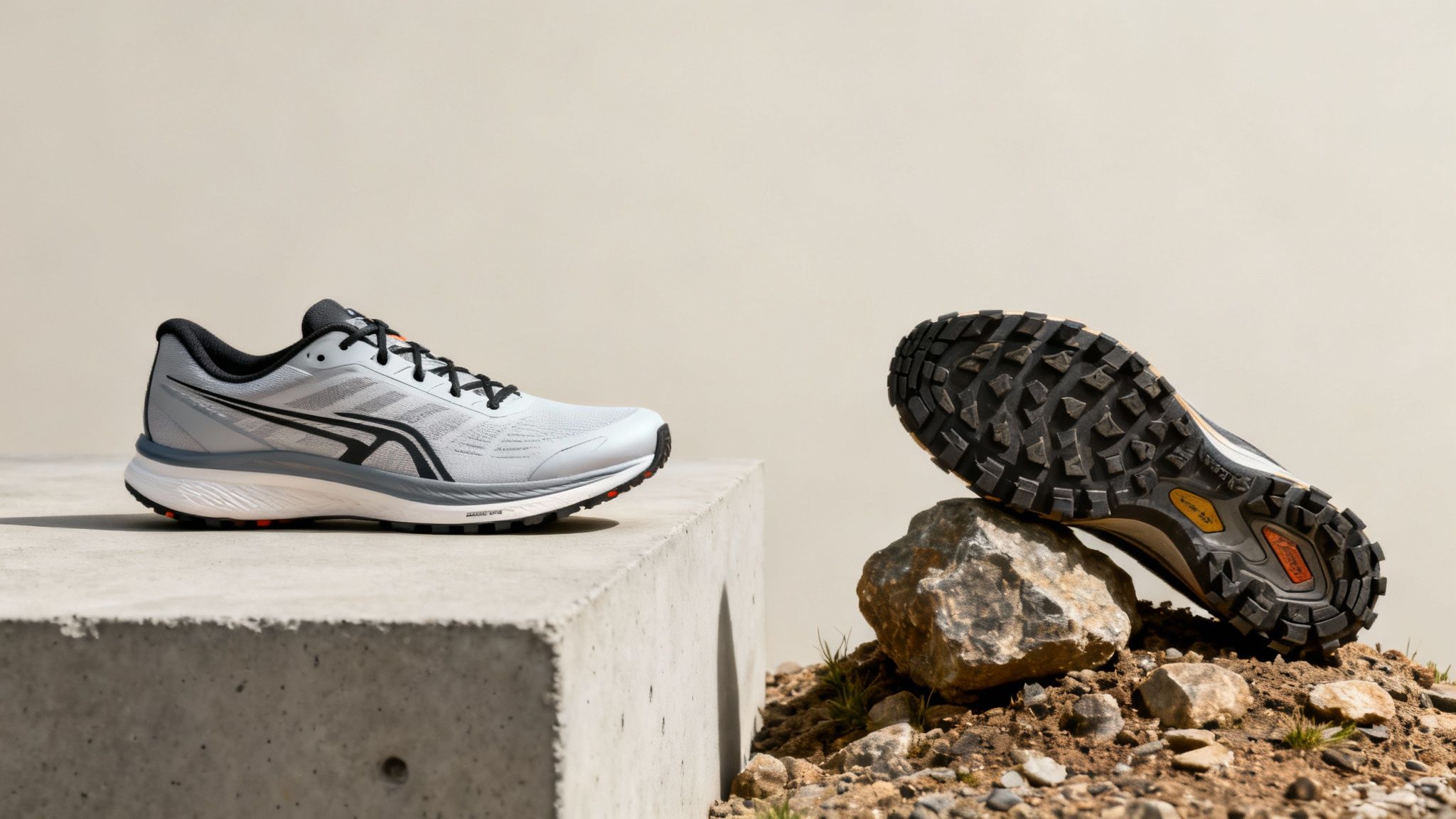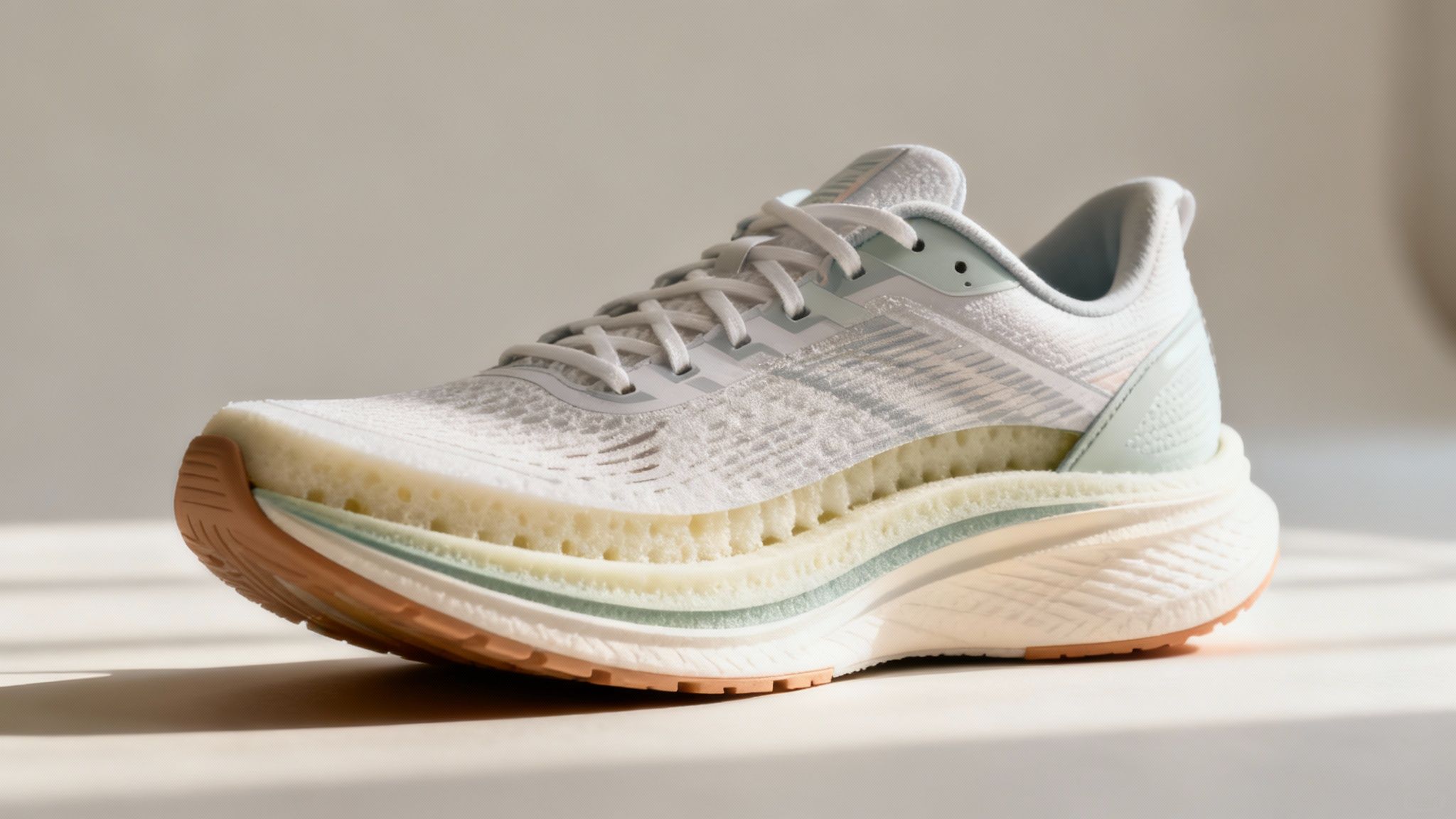Running Shoe Recommendations for Your Best Run
- Flourish Everyday Health And Fitness

- Oct 31
- 8 min read
Updated: Nov 11
Finding the right running shoe is deeply personal. It's about your unique feet, running style, and goals. The Running Shoe Recommendations for Your Best Run guide cuts through the noise to help you find your perfect match with confidence, focusing on how your body moves, the surfaces you run on, and the comfort you need. The right pair works with you, making every run more enjoyable while helping to keep injuries at bay.
Index of Sections:
Understanding Your Gait to Prevent Injury: Learn how your foot's natural roll (pronation) impacts shoe selection and injury prevention.
Matching Your Shoes to Your Running Surface: Discover key differences between road, trail, and gym shoes.
How to Decode Cushioning and Support: Understand terms like "stack height" and "heel-to-toe drop."
Top Running Shoe Models for Men and Women: Curated recommendations for different running needs.
Extending Your Shoe Life and Running Health: Tips on shoe care and knowing when to replace them.
Informative Health Information: Explore the connection between footwear and running-related injuries.
Comparison of Well-Being Trends: How running shoe technology fits into broader health and wellness movements.
Common Questions About Running Shoes: Quick answers to frequently asked questions.

Understanding Your Gait to Prevent Injury
Your running gait is your unique movement pattern, and understanding it is the first step to finding the right shoes. A key part of gait is pronation, the natural inward roll of your foot upon landing. This motion is your body's built in shock absorber. The goal isn't to stop it, but to ensure it's balanced. When that roll is excessive or insufficient, it can throw your body out of alignment and lead to injuries.
The Three Types of Pronation
Knowing your pronation pattern determines whether you need a neutral shoe or one with added support.
Neutral Pronation: The ideal state, where your foot rolls inward by about 15%, absorbing shock efficiently. Shoe wear is typically even across the ball of the foot and heel.
Overpronation: The foot rolls inward more than 15%, often associated with low arches. This can cause instability and stress on the inner ankle, shins, and knees.
Supination (Underpronation): The foot doesn't roll inward enough, placing most of the impact on the outside of the foot. It's common in runners with high, rigid arches and can lead to issues like IT band syndrome.
Discover Your Arch Type with the Wet Test
A simple "wet test" at home can give you a good indication of your arch type and pronation.
Pour a shallow layer of water into a pan.
Wet the sole of one foot.
Step onto a dry piece of cardboard or a dark towel.
Examine the footprint.
A full footprint suggests a low arch (potential over pronation). Seeing only the heel and ball of your foot indicates a high arch (potential supination). A print with a distinct curve along the inside is a sign of a neutral arch.
This infographic guides you from gait analysis to selecting a shoe based on your running surface and cushioning preference.

Choosing the Right Shoe for Your Gait
Match your arch type to the appropriate shoe category for optimal support.
Neutral Shoes: Best for neutral pronators and most supinators, focusing on cushioning without motion control features.
Stability Shoes: Designed for mild to moderate overpronation, using guide rails or medial posts to gently correct foot alignment.
Motion Control Shoes: Offer maximum support for severe overpronators, with a firmer, more rigid structure to limit excessive inward roll.

Matching Your Shoes to Your Running Surface
The surface you run on dictates the grip, protection, and cushioning you need. A shoe designed for smooth pavement will feel inadequate on a rocky trail, and vice versa. Matching your shoe to your environment is a critical step toward comfort and injury prevention.
Road Running Shoes: The Pavement Specialists
Road shoes are designed for hard, consistent surfaces like asphalt, concrete, and treadmills. Their design prioritizes cushioning to absorb impact and flexibility for a smooth stride.
Lightweight Construction: Built for a quick, nimble feel.
Breathable Uppers: Often use engineered mesh for ventilation to keep feet cool.
Flexible Design: Promotes a natural foot motion from landing to toe-off.
Trail Running Shoes: The Off-Road Explorers
For dirt paths, rocky terrain, and muddy hills, trail shoes provide protection, stability, and aggressive grip.
Durable Uppers: Made from rugged materials to resist abrasions and tears.
Aggressive Outsoles: Feature deep lugs to dig into soft ground and grip uneven surfaces.
Protective Features: Many include a rock plate in the midsole to shield feet from sharp objects.
Road vs. Trail: A Clear Comparison
Feature | Road Running Shoes | Trail Running Shoes |
|---|---|---|
Outsole | Flatter with minimal tread for smooth surfaces. | Deep, aggressive lugs for superior grip. |
Midsole | Focused on cushioning and shock absorption. | Often includes a rock plate for underfoot protection. |
Upper | Lightweight, breathable mesh for ventilation. | Durable, reinforced materials to resist abrasions. |
Weight | Generally lighter for a faster feel. | Heavier and more robust for increased durability. |

How to Decode Cushioning and Support
Understanding terms like "stack height" and "drop" is key to finding a shoe that feels right. Shoe cushioning acts as a suspension system, absorbing the impact force of up to three times your body weight with each step. The right amount is subjective, some runners prefer a minimalist feel, while others opt for maximalist cushioning.
Understanding Stack Height
Stack height is the amount of material between your foot and the ground, measured in millimeters. A higher stack height generally means more cushioning.
Minimalist (Low Stack): Very little cushioning, promoting a "barefoot" running style. Requires a significant adaptation period.
Maximalist (High Stack): Thick midsoles for maximum impact protection, ideal for long distances or recovery runs.
What is Heel-to-Toe Drop
Heel-to-toe drop is the height difference between the heel and forefoot, also in millimeters. It influences your running form.
High Drop (8+ mm): Common in traditional shoes, it can reduce strain on the Achilles and calves. Best for heel strikers.
Low/Zero Drop (0-4 mm): Puts the foot in a more level stance, encouraging a midfoot or forefoot strike. Requires a gradual transition to avoid overloading the calves.
Understanding stack height and drop allows you to choose a shoe that matches your body's mechanics and comfort preferences.
Top Running Shoe Models for Men and Women
With a handle on your gait, terrain, and cushioning needs, let's review specific shoe models. This list provides a starting point with standout options known for consistent performance.
Best for Neutral Runners (Daily Training)
For a neutral gait, the focus is on balanced cushioning and a smooth ride.
Brooks Ghost 16 (Men's & Women's): Legendary for its reliable, soft, and smooth ride. The DNA LOFT v3 cushioning provides a plush feel suitable for daily miles.
Hoka Clifton 9 (Men's & Women's): Known for maximalist cushioning, the Clifton offers excellent shock absorption without excess weight, perfect for long or recovery runs.
Best for Stability (Overpronation Support)
Stability shoes offer gentle guidance to counter over pronation and reduce strain on joints.
ASICS GEL-Kayano 31 (Men's & Women's): An icon in the stability category, it combines plush cushioning with a supportive frame for a secure ride over any distance.
Saucony Guide 18 (Men's & Women's): Strikes a balance between stability and flexibility with a supportive frame and responsive cushioning.
Best for Trail Running (Off-Road Adventures)
Trail shoes must provide durability, traction, and protection for varied terrain.
Hoka Speedgoat 6 (Men's & Women's): A trail beast with incredible grip from its Vibram Megagrip outsole and generous cushioning to absorb impact from rocks and roots.
Brooks Cascadia 17 (Men's & Women's): A versatile all round shoe offering a mix of protection, stability, and traction, with a rock shield for underfoot safety.
Extending Your Shoe Life and Running Health
Proper shoe care is crucial for injury prevention. A worn-out shoe loses its supportive properties, forcing your body to compensate and increasing stress on joints and muscles. While the 300-500 mile guideline is common, it's better to pay attention to visual and sensory cues.
How to Spot a Worn-Out Shoe
Crushed Midsole: Deep wrinkles in the midsole foam indicate the cushioning is compressed and ineffective.
Worn Tread: Smooth, bald spots on the outsole mean you've lost crucial grip and stability.
New Aches and Pains: Unexplained discomfort in your feet, shins, or knees can often be traced back to worn-out shoes.
Making Your Shoes Last Longer
Extend the life of your shoes with proper care. Rotating between at least two pairs allows the foam midsole 24 hours to decompress, which can reduce injury risk by up to 39% (Messier et al., 2018). Avoid machine washing; instead, hand-wash with mild soap and cold water, then air dry away from direct heat.
Informative Health Information
The right running shoes are a cornerstone of injury prevention. Improper footwear is a leading contributor to common running ailments like plantar fasciitis, Achilles tendonitis, and shin splints (van Gent et al., 2007). Shoes that don't match your gait type can exacerbate biomechanical imbalances. For example, an overpronator running in a neutral shoe may experience increased stress on their medial knee, potentially leading to patellofemoral pain syndrome.
Conversely, a well chosen shoe provides the necessary support and cushioning to mitigate impact forces, promoting proper alignment from the foot up through the kinetic chain (ankles, knees, hips). This alignment reduces abnormal stress on soft tissues and joints, allowing you to run more efficiently and with a lower risk of injury.
Comparison of Well Being Trends
Modern running shoe technology is part of a larger wellness movement emphasizing personalized health and proactive injury prevention. Just as wearable tech tracks heart rate and sleep, advanced footwear aims to optimize biomechanics. This trend moves beyond simple comfort, integrating data-driven design to enhance performance and longevity in the sport.
The minimalist running trend, for instance, challenged traditional shoe design by advocating for a more natural foot motion to strengthen intrinsic foot muscles. While not universally adopted, it spurred innovation toward lower drop shoes and a greater focus on running form. Today, the market offers a spectrum of choices, from maximalist cushioning that aligns with a comfort, first wellness approach to responsive, high tech racers for performance, oriented goals. This variety allows runners to select gear that aligns with their personal well being philosophy, whether it's focused on peak performance, injury resilience, or pure enjoyment.
Common Questions About Running Shoes
Here are answers to some frequently asked questions.
How Much Should I Spend on Running Shoes?
A quality pair of running shoes typically costs between $120 and $160. This price range reflects durable materials, advanced cushioning technology, and construction designed to last for hundreds of miles. While more expensive models with features like carbon plates exist, they are often specialized for racing and unnecessary for daily training.
Can I Use My Running Shoes for Other Activities?
It's best to reserve your running shoes exclusively for running. They are designed for forward motion and may not provide adequate support for the lateral movements common in gym workouts. Using them for walking or other activities will also wear down the midsole cushioning faster, reducing their lifespan for running.
Do I Need a Professional Gait Analysis?
While not essential for everyone, a professional gait analysis can be valuable, especially for new runners or those with persistent injuries. However, the at home "wet test" is an effective way to determine your arch type, which is often sufficient information to choose between a neutral, stability, or motion control shoe.
References
Fortune Business Insights. (2023). Athletic Footwear Market Size, Share & COVID-19 Impact Analysis. explore more about these market trends
Future Market Insights. (2023). Running Shoes Market Outlook. explore more about the running shoe market
Messier, S. P., Martin, D. F., Mihalko, S. L., et al. (2018). A 2-Year Prospective Cohort Study of Overuse Running Injuries: The Runners and Injury Longitudinal Study (TRAILS). The American Journal of Sports Medicine, 46(9), 2211–2221.
van Gent, R. N., Siem, D., van Middelkoop, M., van Os, A. G., Bierma-Zeinstra, S. M., & Koes, B. W. (2007). Incidence and determinants of lower extremity running injuries in long distance runners: a systematic review. British Journal of Sports Medicine, 41(8), 469–480.
For further reading on pronation, visit in-depth articles on pronation.
To learn about the benefits of a shoe rotation, see advantages of a running shoe rotation.
At Flourish-Everyday, our goal is to cut through the noise and make finding the right gear and health info simple. Visit us to explore curated recommendations and expert advice to support your wellness journey.


Comments